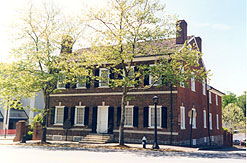
Home > Research Projects >Pianos > Mary Todd Lincoln House Thompson Piano
Description by Dwight Newton, 2006.
This piano is in the Mary Todd Lincoln House on Main Street in Lexington, Kentucky. The house was built ca. 1803-1806 as an inn, but was purchased by the Todd family in 1832. Mary Todd was born in their previous home a few blocks away. As with most of the objects in the house, the piano is not original to the Todd family or to the house, but is appropriate to its early period,

We believe the piano was made ca. 1825 by William Thompson of Lexington. This is clear example of an English style square piano in the style of Geib or Astor, double strung, with an English double action. The case has the common three flat-fronted shallow drawers. There have been some modern crude repairs where wood was added to the bottom to help support the drawers, but this is not plainly visible. There is no serial number evident.
The case is in reasonably good condition, with only a few problems with veneers and brass inlays. To the casual observer (most visitors see the instrument from several feet away behind a velvet rope) it appears to be cosmetically acceptable. There is evidence that the keys may have been levelled for the sake of appearance. The sharps are not ebony, but some softer material stained black. Many are badly worn while the ivories and keyfronts are virtually all clean and unused in appearance. I suspect they have been replaced, again for cosmetic purposes.
The interior is badly damaged and dirty. A number of the hammers are stored loose in the soundbox and others may be missing. Several of the strings are missing, especially in the middle range. The dampers are twisted and bent on their support wires, suggesting that heavy objects were dropped on them or pulled across them. The damper pedal and its support leg are missing. There appear to be no other effects mechanisms. The right-hand lid support was apparently broken and is missing. There are supports here and there around the interior perimiter of the case that may have supported an interior lid. The action is essentially frozen, with almost no movement on any of the keys, likely due to wood swelling. Otherwise the instrument seems to be quite straight and square, with no significant evidence of twisting or warping under tension.
The name board design is strikingly similar to that of Astor & Horwood.
The ormolu and brightwork is in very good condition and is nicely made.
The veneers and nearly all visible wood surfaces appear to be mahogany. Where the substrate is visible, there appears to be a good deal of pine used for the primary casework, as is quite evident on the back of the name board. (This needs to be verified.)
The keys and damper heads are all numbered.
This interior soundboard support is a three-ply veneered board. The use of "plywood" seems unusual.
The drawers have wide dovetails and pine secondary woods with a good dark patina. They fit very snugly -- another indication of swelling from humidity.
Copyright © 2006 by Dwight Newton. All rights reserved.

© 2001-2008 D.Newton/Mewzik.com